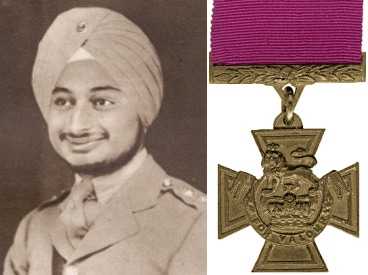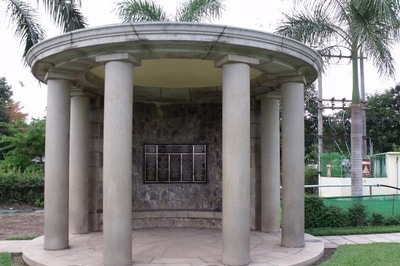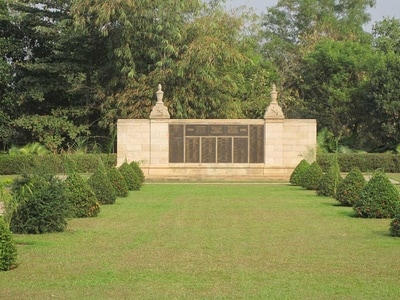TAUKKYAN MEMORIAL AND CREMATION MEMORIAL
Yangon
Myanmar
GPS Coordinates: Latitude: 17.03567, Longitude: 96.13127
Location Information
Taukkyan War Cemetery is in Taukkyan town in the township of Mingaladon, Yangon greater area, on the main highway No 1 (Pyay Road). From the centre of the city of Yangon, it is 21 miles north and 11 miles from the International airport, 1 hour drive from the centre of Rangoon and 30 minutes from the International airport. Exact location of the cemetery is North (17º02'08.24") and East (96º07'55.28").
Visiting Information
Taukkyan War Cemetery is open everyday from 07:00-17:00.
Accompanied wheelchair access is possible through the main entrance and unaccompanied through the side entrance adjacent to the office.
Historical Information
The TAUKKYAN MEMORIAL commemorates 46 servicemen of both wars who died and were buried elsewhere in Burma (now Myanmar) but whose graves could not be maintained. It should not be confused with the much larger Rangoon Memorial which commemorates 27,000 men with no known graves and is also located within Taukkyan War Cemetery.
The 19 First World War casualties commemorated on this memorial served in garrisons and lie buried in the following cemeteries: Aungban Cemetery; Bassein Church of England Cemetery; Diamond Island Cof E Cemetery; Kungyangon Cemetery; Lwekaw Cemetery; Mangthone Military Grave; Prome Government Cemetery; Pyinmana Cemetery; Shwebo Cantonment Cemetery.
Commemorated from World War One: United Kingdom 20.
Commemorated from World War Two: United Kingdom 22, India 2, New Zealand 2. Total 26.
The memorial stands in TAUKKYAN WAR CEMETERY, which is the largest of the three war cemeteries in Burma. It was begun in 1951 for the reception of graves from four battlefield cemeteries at Akyab, Mandalay, Meiktila and Sahmaw which were difficult to access and could not be maintained. The last was an original 'Chindit' cemetery containing many of those who died in the battle for Myitkyina. The graves have been grouped together at Taukkyan to preserve the individuality of these battlefield cemeteries
Burials were also transferred from civil and cantonment cemeteries, and from a number of isolated jungle and roadside sites. Because of prolonged post-war unrest, considerable delay occurred before the Army Graves Service were able to complete their work, and in the meantime many such graves had disappeared. However, when the task was resumed, several hundred more graves were retrieved from scattered positions throughout the country and brought together here.
The cemetery now contains 6,374 Commonwealth burials of the Second World War, 867 of them unidentified.
In the 1950s, the graves of 52 Commonwealth servicemen of the First World War were brought into the cemetery from the following cemeteries where permanent maintenance was not possible: Henzada (1); Meiktila Cantonment (8); Thayetmyo New (5); Thamakan (4); Mandalay Military (12) and Maymyo Cantonment (22).
Taukkyan War Cemetery also contains:
The RANGOON MEMORIAL, which bears the names of almost 27,000 men of the Commonwealth land forces who died during the campaigns in Burma and who have no known grave.
The TAUKKYAN CREMATION MEMORIAL, which commemorates more than 1,000 Second World War casualties who died in campaigns in Burma whose remains were cremated in accordance with their faith.
Commemorated: India 980, United Kingdom 80. Total 1,060.
Memorial pictures used with the permission of the Commonwealth War Graves Commission
Taukkyan War Cemetery is in Taukkyan town in the township of Mingaladon, Yangon greater area, on the main highway No 1 (Pyay Road). From the centre of the city of Yangon, it is 21 miles north and 11 miles from the International airport, 1 hour drive from the centre of Rangoon and 30 minutes from the International airport. Exact location of the cemetery is North (17º02'08.24") and East (96º07'55.28").
Visiting Information
Taukkyan War Cemetery is open everyday from 07:00-17:00.
Accompanied wheelchair access is possible through the main entrance and unaccompanied through the side entrance adjacent to the office.
Historical Information
The TAUKKYAN MEMORIAL commemorates 46 servicemen of both wars who died and were buried elsewhere in Burma (now Myanmar) but whose graves could not be maintained. It should not be confused with the much larger Rangoon Memorial which commemorates 27,000 men with no known graves and is also located within Taukkyan War Cemetery.
The 19 First World War casualties commemorated on this memorial served in garrisons and lie buried in the following cemeteries: Aungban Cemetery; Bassein Church of England Cemetery; Diamond Island Cof E Cemetery; Kungyangon Cemetery; Lwekaw Cemetery; Mangthone Military Grave; Prome Government Cemetery; Pyinmana Cemetery; Shwebo Cantonment Cemetery.
Commemorated from World War One: United Kingdom 20.
Commemorated from World War Two: United Kingdom 22, India 2, New Zealand 2. Total 26.
The memorial stands in TAUKKYAN WAR CEMETERY, which is the largest of the three war cemeteries in Burma. It was begun in 1951 for the reception of graves from four battlefield cemeteries at Akyab, Mandalay, Meiktila and Sahmaw which were difficult to access and could not be maintained. The last was an original 'Chindit' cemetery containing many of those who died in the battle for Myitkyina. The graves have been grouped together at Taukkyan to preserve the individuality of these battlefield cemeteries
Burials were also transferred from civil and cantonment cemeteries, and from a number of isolated jungle and roadside sites. Because of prolonged post-war unrest, considerable delay occurred before the Army Graves Service were able to complete their work, and in the meantime many such graves had disappeared. However, when the task was resumed, several hundred more graves were retrieved from scattered positions throughout the country and brought together here.
The cemetery now contains 6,374 Commonwealth burials of the Second World War, 867 of them unidentified.
In the 1950s, the graves of 52 Commonwealth servicemen of the First World War were brought into the cemetery from the following cemeteries where permanent maintenance was not possible: Henzada (1); Meiktila Cantonment (8); Thayetmyo New (5); Thamakan (4); Mandalay Military (12) and Maymyo Cantonment (22).
Taukkyan War Cemetery also contains:
The RANGOON MEMORIAL, which bears the names of almost 27,000 men of the Commonwealth land forces who died during the campaigns in Burma and who have no known grave.
The TAUKKYAN CREMATION MEMORIAL, which commemorates more than 1,000 Second World War casualties who died in campaigns in Burma whose remains were cremated in accordance with their faith.
Commemorated: India 980, United Kingdom 80. Total 1,060.
Memorial pictures used with the permission of the Commonwealth War Graves Commission
Taukkyan Memorial
Taukkyan Cremation Memorial

IEC/5504 Lieutenant
Karamjeet Singh Judge, V. C.
4th Bn. 15th Punjab Regiment
18th March 1945, aged 22.
Column 25.
Son of Sarda Sunder Singh, Inspector-General of Police, of Kapurthala, India.
Citation:
The following details are taken from the London Gazette of 3rd July, 1945:In Burma on 18th March, 1945, Lieut. Karamjeet Singh Judge commanded a platoon of a company of the 15th Punjab Regiment ordered to capture the Cotton Mill area at Myingyan against stiff enemy resistance from numerous bunkers. Time and again the infantry were held up by heavy fire from bunkers not visible to the tanks. On every such occasion Lieut. Karamjeet Singh Judge, with complete disregard for his own safety, went forward to re-call the tanks and direct them to these bunkers. In this way ten bunkers were eliminated, and this brilliant and courageous officer in every case led the infantry charges against the bunkers when the tanks had dealt with them. The Lieutenant was mortally wounded leading a section to clear the last three bunkers, but his men were able to storm the strong point and complete a long and arduous task. During the battle Lieut. Karamjeet Singh Judge showed cool and calculated bravery; he dominated the entire battlefield by his numerous successive acts of superb gallantry. In three previous and similar actions this young officer had proved himself an outstanding leader. In this, his last, action he gave a superb example of inspiring leadership and matchless courage.
Karamjeet Singh Judge, V. C.
4th Bn. 15th Punjab Regiment
18th March 1945, aged 22.
Column 25.
Son of Sarda Sunder Singh, Inspector-General of Police, of Kapurthala, India.
Citation:
The following details are taken from the London Gazette of 3rd July, 1945:In Burma on 18th March, 1945, Lieut. Karamjeet Singh Judge commanded a platoon of a company of the 15th Punjab Regiment ordered to capture the Cotton Mill area at Myingyan against stiff enemy resistance from numerous bunkers. Time and again the infantry were held up by heavy fire from bunkers not visible to the tanks. On every such occasion Lieut. Karamjeet Singh Judge, with complete disregard for his own safety, went forward to re-call the tanks and direct them to these bunkers. In this way ten bunkers were eliminated, and this brilliant and courageous officer in every case led the infantry charges against the bunkers when the tanks had dealt with them. The Lieutenant was mortally wounded leading a section to clear the last three bunkers, but his men were able to storm the strong point and complete a long and arduous task. During the battle Lieut. Karamjeet Singh Judge showed cool and calculated bravery; he dominated the entire battlefield by his numerous successive acts of superb gallantry. In three previous and similar actions this young officer had proved himself an outstanding leader. In this, his last, action he gave a superb example of inspiring leadership and matchless courage.









